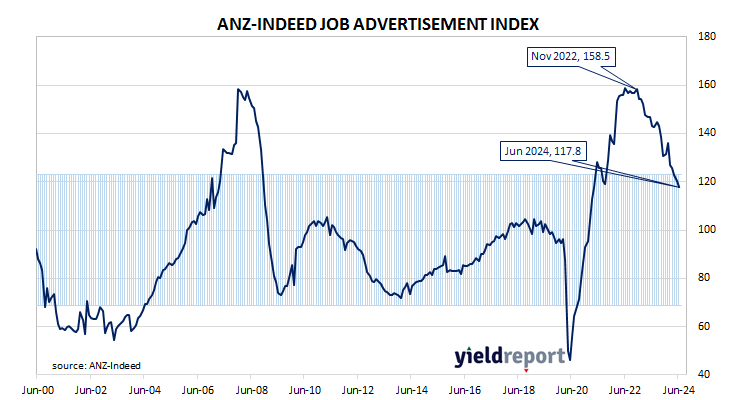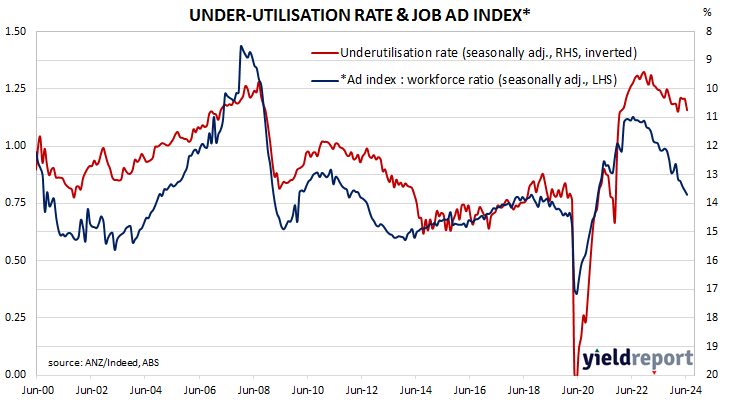Summary: Job ads down 2.2% in June; 17.6% lower than June 2023; ANZ: down again but still well above pre-pandemic levels; ACGB yields rise; rate-rise expectations firm slightly; ANZ: similar story in other parts of labour market; ad index-to-workforce ratio declines.
From mid-2017 onwards, year-on-year growth rates in the total number of Australian job advertisements consistently exceeded 10%. That was until mid-2018 when the annual growth rate fell back markedly. 2019 was notable for its reduced employment advertising and this trend continued into the first quarter of 2020. Advertising then plunged in April and May of 2020 as pandemic restrictions took effect but recovered quite quickly, reaching historically-high levels in 2022.
According to the latest reading of the ANZ-Indeed Job Ads Index, total job advertisements in June decreased by 2.2% on a seasonally adjusted basis. The index fell from 120.5 in May to 117.8, with the loss following falls of 1.9% in May and 2.4% in March. On a 12-month basis, total job advertisements were 17.6% lower than in June 2023, up from May’s revised figure of -17.9%.
“Despite this continued moderation, the level of Job Ads is still well above pre-pandemic levels,” said ANZ economist Madeline Dunk.
The update was released on the same day as the Melbourne Institute’s latest Inflation Gauge reading and Commonwealth Government bond yields moved higher across the curve, although they generally lagged the rises of long-term US yields on Friday night. By the close of business, the 3-year ACGB yield had added 5bps to 4.10%, the 10-year yield had gained 7bps to 4.39% while the 20-year yield finished 9bps higher at 4.70%.
Expectations regarding rate rises in the next twelve months firmed slightly by the end of the day. In the cash futures market, contracts implied the cash rate has some chance of rising above the current rate of 4.32% in the short-term, with an average of 4.325% through July, 4.395% in August and 4.47% in November. February 2025 contracts implied 4.44% while May 2025 contracts implied 4.345%, just above the current cash rate.
“We’re seeing a similar story in other parts of the labour market, with indicators easing from strong starting positions,” Dunk added. “So far, a lot of the adjustment in the labour market has been through hours worked. But with average hours worked per person back in line with the long-run trend, we think the pace of employment growth will slow from here.”
The inverse relationship between job advertisements and the unemployment rate or the underemployment rate has been quite strong (see below chart), although ANZ themselves called the relationship between the series into question in early 2019.
A higher job advertisement index as a proportion of the labour force is suggestive of lower unemployment rates in the near future while a lower ratio suggests higher unemployment rates will follow. June’s ad index-to-workforce ratio declined from 0.81 to 0.79.
In 2008/2009, advertisements plummeted and Australia’s unemployment rate jumped from 4% to nearly 6% over a period of 15 months. When a more dramatic fall in advertisements took place in April 2020, the unemployment rate responded much more quickly.



